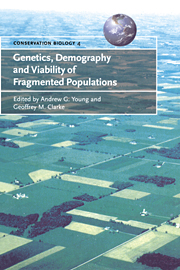Book contents
- Frontmatter
- Contents
- List of contributors
- Foreword by Peter F. Brussard
- Preface
- 1 Introduction: genetics, demography and the conservation of fragmented populations
- Part I Introductory concepts
- 2 Managing and monitoring genetic erosion
- 3 Inbreeding and outbreeding depression in fragmented populations
- 4 Demography and extinction in small populations
- 5 The metapopulation paradigm: a fragmented view of conservation biology
- 6 Population viability analysis for conservation: the good, the bad and the undescribed
- 7 Applications of population genetics and molecular techniques to conservation biology
- Part II Animal case studies
- Part III Plant case studies
- References
- Index
2 - Managing and monitoring genetic erosion
Published online by Cambridge University Press: 29 January 2010
- Frontmatter
- Contents
- List of contributors
- Foreword by Peter F. Brussard
- Preface
- 1 Introduction: genetics, demography and the conservation of fragmented populations
- Part I Introductory concepts
- 2 Managing and monitoring genetic erosion
- 3 Inbreeding and outbreeding depression in fragmented populations
- 4 Demography and extinction in small populations
- 5 The metapopulation paradigm: a fragmented view of conservation biology
- 6 Population viability analysis for conservation: the good, the bad and the undescribed
- 7 Applications of population genetics and molecular techniques to conservation biology
- Part II Animal case studies
- Part III Plant case studies
- References
- Index
Summary
ABSTRACT
Fragmentation, decline or perturbation of a species can lead to genetic changes. Often these changes can have adverse implications for the conservation of the species, but there is a diversity of responses by different species. Therefore, managers must use a variety of methods to detect, avert or remedy genetic changes which actually affect population viability. The objective should be to maintain optimal fitness in changing conditions, rather than to maintain specific arrays of phenotypes. This effort should be accompanied by monitoring of genetic contributions to fitness, to confirm the effectiveness of the conservation genetic strategy. This approach presumes we have the ability to directly or indirectly manipulate and measure adaptive genetic variants, such as many multilocus (quantitative) traits, or a representative array of single-locus traits associated with fitness. Such analyses are challenging, but are becoming more accessible. It is also important to examine the association between adaptive diversity and surrogates which may be more amenable to monitoring or manipulation, such as neutral DNA variants, size or number of populations, or the range of ecological conditions in which populations of the species are found. In evaluating different types of genetic variation and their surrogates, two important points are the replaceability of the variation (that is, how long it would take for the variation to be replaced) and its utility (likely contribution to adaptation).
INTRODUCTION
Biodiversity conservation targets three interdependent levels: ecosystems, species and genes. This chapter will highlight genetic variation within species, an area which is currently experiencing a wealth of new field, laboratory and statistical methods.
- Type
- Chapter
- Information
- Publisher: Cambridge University PressPrint publication year: 2000
- 43
- Cited by

